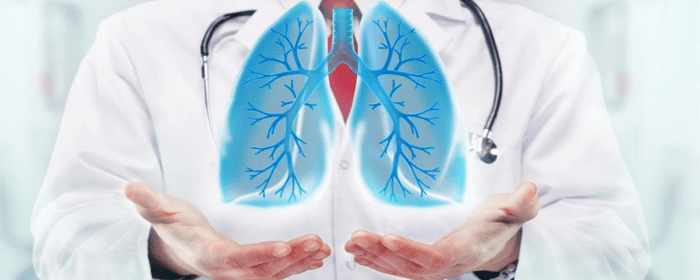
by admin | Nov 12, 2020 | COPD, Stem Cell Therapy
Several recent studies have shown that adult stem cells, and specifically mesenchymal stem cells (MSC), appear to support the regeneration and protection of lung tissue, making them a very promising potential next-generation therapy option for the treatment of COPD.
Known treatments for COPD are designed to address symptoms and not the actual cause of the condition; considering that COPD continues to be among the leading causes of death among developed countries and that it’s considered to be a preventable and treatable disease there is a clear and compelling need to develop more effective therapeutic strategies.
As COPD develops, its inflammatory properties are characterized by the death of the epithelial cells, loss of the terminal air-space within the lung, and ongoing breakdown of lung tissue responsible for stability, elastic recoil, and other physiological functions essential for respiration.
Since the damage to these cells is permanent and not repairable, researchers continue to explore the use of MSCs as a potential option to repair and restore lung structure and lung function in people living with COPD.
Currently, any therapeutic-based COPD treatment option relies on the continued use of bronchodilators and/or corticosteroids to reduce the symptoms of COPD. While both of these drugs have been able to slow the worsening of COPD symptoms, the benefits appear to be ineffective as a long-term treatment option for even mild to moderate COPD.
Because of their capacity to induce growth of skeletal muscle cells, blood, fat, vascular systems, and connective tissues throughout the body, and since they seemingly have a capacity for self-renewal, MSCs are now being considered as a therapeutic treatment option for COPD.
In addition to their versatility throughout various cells, tissues, and systems, MSCs are relatively simple to isolate, they expand with high efficiency, are easily able to be processed and transported from the lab setting to point-of-use, and are highly compatible with different delivery methods and formulations currently being used by medical professionals.
Early research has also demonstrated that MSCs possess powerful immunosuppressive properties and are easily able to seek out and migrate to specific sites of tissue injury; this appears to be especially promising in the tissue of the lungs where not only have MSCs demonstrated the ability to suppress inflammation and growth factor production but also been found to reduce fluid retention within the lungs.
While these findings are promising, Phase II clinical trials to establish the use of Mesenchymal stem cells as a therapeutic treatment in patients with severe COPD are currently ongoing. Specifically, this trial is examining how effective MSCs derived from normal healthy adult donors in the treatment of COPD.
Although further study is required, early indications show promise that stem cell therapy, and specifically the use of MSCs, could be a very effective therapeutic treatment option in patients with moderate to severe COPD.
Reference: (n.d.). Mesenchymal stem cell therapy for the treatment of … – PubMed. Retrieved November 25, 2020, from https://pubmed.ncbi.nlm.nih.gov/20384521

by admin | Oct 30, 2020 | COPD, Stem Cell Research, Stem Cell Therapy
Chronic obstructive pulmonary disease (COPD) is a lung condition that makes it hard for patients to breathe. In COPD, small airways in the lungs thicken and lose their elasticity. People with COPD have shortness of breath, especially during physical activity. Patients with severe COPD may experience a more challenging quality of life. COPD patients may experience several exacerbations a year which require a stay in the hospital.
Patients with COPD typically need one or more inhalers a day. These inhalers help to open airways and, in some cases, decrease lung inflammation. Patients who also have bronchiectasis may need to take an oral antibiotic every day. During a COPD exacerbation, patients usually must receive powerful steroid treatments intravenously, routine breathing treatments, and supplemental oxygen.
People with COPD are more prone to lung infections, and so they usually receive IV antibiotics for pneumonia. Those who successfully stop smoking can help to prevent further lung damage, however, the inflammation and lung damage persists for a long time. Today, patients are seeking alternative therapies for COPD. Many are discovering regenerative medicine, also known as stem cell therapy, that may offer an incredibly promising therapy for COPD.
The lungs have a large number of naturally occurring stem cells that can restore function. For example, mice who lose half their lung capacity from experimental COPD survive, and natural stem cells within the lungs can restore their lungs to a natural state within 5 months. Unfortunately, humans with COPD cannot repair their lungs as quickly and as fully as mice can. This is why researchers are studying the use of stem cell treatment to restore lung function in patients with COPD.
Studies have shown that stem cells have the potential to help improve lung function. Stem cell treatment improved oxygen and carbon dioxide exchange, exercise tolerance, and cell injury in early studies.
One review did show that stem cell treatment is “safe and may improve patients’ condition and quality of life; however, larger-scale studies are needed to evaluate efficacy.” More research in humans is needed, but the pre-clinical (aka animal and laboratory) research in this area is quite promising.
Reference: Kokturk N, Yıldırım F, Gülhan PY, Oh YM. Stem cell therapy in chronic obstructive pulmonary disease. How far is it to the clinic?. Am J Stem Cells. 2018;7(3):56-71. Published 2018 Aug 1.

by Stemedix | Oct 12, 2020 | COPD, Stem Cell Therapy
Chronic obstructive pulmonary disease (COPD) is a lung condition in which airflow to and from the lungs is obstructed, making it increasingly difficult to breathe. The World Health Organization estimates that the condition is the third-leading cause of mortality worldwide. There is currently no cure for COPD, although there is a COPD treatment available to help control its progression.
Recently, researchers have begun to study regenerative medicine approaches, which may be used to treat COPD and actually reverse some of the damage already done to the lungs. Stem cell therapy is one particularly promising option.
How Can Stem Cells Be Used as a COPD Treatment?
Stem cells act as the foundation for all cell types. They have the ability to proliferate and transform into adult cells and can repair injuries. They also have regenerative properties and can therefore help heal compromised lung tissue.
At the site of a wound, stem cells differentiate and release pro-inflammatory cytokines and growth factors to help draw healing proteins to the injury. Because the stem cells themselves are anti-inflammatory and anti-fibrosis (meaning they reduce the formation and build-up of scar tissue), they appear to be particularly useful for treating conditions, such as COPD.
How Are Patients Responding to Stem Cell Therapy for COPD?
While clinical trials and studies are still ongoing, stem cell therapy has provided patients with improvements in quality of life, such as improved energy levels, improved sleep quality, and reduction in the rate of tissue damage, and restoration of lung structure and function.
What Is the Process for Stem Cell Therapy for COPD?
Patients who are eligible candidates for stem cell therapy can either have stem cells retrieved from their own tissue, such as fat tissue or donated from umbilical cord tissue. The process is quick, simple, and painless. Stem cell therapy is well-tolerated in the majority of cases, is considered to be safe, and offers a potential alternative option for patients to consider. Contact a Care Coordinator today for a free assessment!

by admin | Oct 29, 2019 | COPD, Health Awareness
A decline in lung function can be both age-related and result from a disease, such as chronic obstructive pulmonary disease (COPD). Although there are medications available to help patients manage the symptoms of COPD, the disease has no cure. Thus, for both age-related and COPD-related decline in lung function, patients are limited in terms of their treatment options.
Recently, researchers discovered a potential therapy in flavonoids for improving lung function. This group of phytonutrients is found in nearly all vegetables and fruits and is known to have powerful antioxidants and anti-inflammatory properties. While there have been plenty of previous research showcasing flavonoids’ abilities in medical applications, studies on their effect on lung function have been limited.
In the most recent research, investigators focused on anthocyanins, a type of flavonoid which has been found in lung tissue shortly after being ingested. Based on findings, it appears that the plant chemicals may play an important role in minimizing mucus and inflammatory secretions. Study participants who consumed the most anthocyanins experienced improvements in a number of key lung function indicators over their peers, including a slower rate of decline in FEV1, which measures how much air a person can exhale in a second. They also experienced a slower rate of decline in FVC, the amount of air exhaled after taking a deep breath. Benefits were realized across people who had smoked as well as those who had not.
Good Sources of Anthocyanins
While the researchers note that quitting is the best choice smokers can make to improve their lung function, a diet rich in anthocyanins could be an effective way to boost lung function in former smokers and people who have never smoked. Anthocyanins are found naturally in red onions, berries, grapes, tomatoes, acai, kidney beans, and tart cherries.

by admin | Jul 6, 2018 | Stem Cell Therapy, COPD, Stem Cell Research
Chronic obstructive pulmonary disease (COPD) is an incurable lung disorder which makes it difficult to breathe. It includes chronic bronchitis and emphysema and is characterized by a persistent cough and mucus production. While it is not curable, it can be managed through ongoing treatment to provide patients with effective symptom control and good quality of life. There are a few key types of lung damage that can occur in COPD:
- With emphysema, the air sacs (alveoli) in the lungs are compromised. The walls of alveoli are stretched and actually cause the lungs to expand, which makes it more difficult for air to move in and out.
- In chronic bronchitis, the bronchial tubes are constantly inflamed, which limits airflow. In specific, the cilia (hair-like structures in the airways) become damaged. The airway can also become swollen and clogged.
- Refractory asthma is also marked by swelling of the bronchial airways. Even medications cannot reverse the swelling.
Here, we examine a form of COPD treatment which has been gaining attention recently.
Blood-Derived PRP
Blood-derived platelet-rich plasma (PRP) therapy is increasingly being used to treat a broad range of conditions, including sports injuries and arthritis. The procedure is performed via intravenous blood extraction. After the blood cells are harvested, they are processed, and the platelets are separated from other blood components. With the higher concentration of platelets, the treated blood is then reinserted into the patient with the hopes of reducing inflammation and speeding up the body’s healing process.
The problem with blood-derived PRP is that the evidence illustrating the effectiveness of this treatment for COPD is lacking. While some studies have been performed and suggest the treatment’s ability to support hair regrowth and reduce osteoarthritis pain, the lack of definitive proof supporting PRP therapy’s ability to make a noticeable impact on COPD has spurred criticism.
A Better Alternative
Stem cell PRP takes PRP injections a step further by mixing platelets with stem cells to treat the structural airway issues present in all forms of COPD. In numerous studies, this approach has shown promise. Coupling blood derivatives with stem cell therapy have proven effective in tissue regeneration in areas like the knee and gums, for instance. In one report, researchers concluded that the therapy “offers a promising therapeutic approach that has shown potential in diverse degenerative lung diseases” based on findings across 15 separate studies.
Through traditional PRP treatment, platelets become 5-10 times more concentrated, or 150,000- 450,000 platelets per microliter. When combined with stem cells, however, they become supercharged and platelet counts are much higher. Because research suggests that the therapeutic level for platelet count should be closer to 1,000,000 per cubic milliliter, PRP and stem cells are far more powerful than PRP alone. Moreover, PRP therapy is derived from whole blood alone, meaning it contains very few CD34+ cells – the cells commonly found in the umbilical cord and bone marrow which have the greatest self-renewal capacity – if any.
With stem cell therapy for COPD, it is guaranteed that these cells will be introduced into the body in a higher concentration. They can then promote the healing process, replacing countless cells throughout the entire body, including the lung tissue.

by admin | Jan 30, 2018 | COPD, Stem Cell Research
A recent review published in the International Journal of Molecular Sciences covers evidence demonstrating that Wharton’s jelly mesenchymal stem cells show promise for treating chronic obstructive pulmonary disease (COPD). After analyzing the literature on how stem cells may be applied in COPD treatment, the authors suggest that chronic immune-inflammatory processes are a critical component of COPD that these stem cells may be able to combat.
According to the authors of the study, several characteristics of Wharton’s jelly mesenchymal stem cells make them well suited to therapies against COPD and other immune-inflammatory diseases. These characteristics include their accessibility, their ability to expand and differentiate, and their tendency to avoid the immune reactions that often occur with other types of stem cells. These cells can come from several types of tissue, including adipose tissue, the umbilical cord, and bone marrow, and can differentiate into many different cell types.
Given the inflammatory nature of COPD, the ability of Wharton’s jelly mesenchymal stem cells to avoid serious immune reactions upon implantation may be one of the most important features of these cells. Youthful forms of these stem cells appear particularly promising, as they are agile and even less likely to cause problematic immune reactions. Intuitively, youthful stem cells are healthier in many ways because they have not undergone the biological damage that occurs with aging.
In addition to their relatively low likelihood of causing immune reactions, mesenchymal stem cells have also been shown to relieve inflammation in the airway in some studies. They have done so by producing mucus that can help minimize inflammation, by killing off cells involved in inflammation, by inhibiting the formation of problematic fibrous connective tissue, and by promoting the formation of new blood vessels.
As the reviewers note, the positive results of preclinical investigations justified the initiation of clinical trials using mesenchymal stem cells in COPD. As such, there are currently Phase I and Phase II trials underway and some that have already been completed. One completed study demonstrated the safety of using these stem cells, as no patients experienced serious adverse side effects after stem cell transplantation. The study also showed that the stem cells were associated with a reduction in an inflammatory marker, suggesting that the stem cells may, in fact, help to reduce inflammation in these patients.
Another study also demonstrated safety. It also showed functional improvement in COPD patients. These patients performed better on the breathing spirometry test after stem cell transplantation. This change in performance suggests that the pathological degeneration occurring in the lungs of those with COPD was slowed with the implantation of stem cells. These patients also experienced improved quality of life after the stem cell transplantation.







 St. Petersburg, Florida
St. Petersburg, Florida
